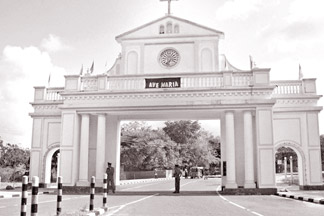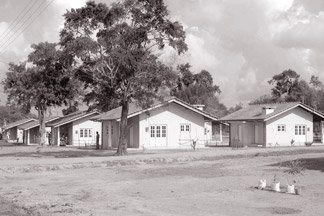|
People’s Bank’s magnanimous gesture:
New era dawns on people of Mannar
Dharman WICKREMARATNE
The scenery at the Mannar coastline on a quiet star-lit night is
mesmerizing. The only sound is the rolling waves hitting the shoreline.
This is the Seelawathura beach, Mannar. It is a unique place and in a
sense a mixture of the scenic beauty of the Passekudah (Batticaloa),
Nilaweli (Trincomalee) and Arugambay (Ampara) beaches.
In ancient times Mannar was a trading centre. The Tamil name for it
denotes ‘The Land of Pearls.’ At one time the place was known as
Maathota - the port where a Princess from Pandurata, India landed to
become King Vijaya’s (543-505 BC) queen. It is the same port where the
giant Bhalluka landed with 60,000 men in 161 BC and also the place from
which King Ilanaga (35-44 AD) fled to Kerala.
 |
|
Approach
road to Madhu Church |
 |
|
Some of the
newly built houses |
History records that the invader Maagha had built forts in Maathota
during the reign of Parakramabahu II (1236-1270 AD). Egyptian Geographer
of Roman origin, Claudius Ptolemy’s map of Sri Lanka identifies Maathota
as Moduttu. According to Archaeological Research the story of Mannar
goes back to pre-historic times.
Mannar’s tragedy
Mannar District is 1506 km in extent and located 35 km South-East of
Dhanushkodi in South India. North of Mannar is the Indian Ocean
extending to the Palk Straits. Towards the East is Mullaitivu and
Vavuniya Districts. On the South are the boundaries of the Puttalam and
Anuradhapura Districts. To the West is the so-called Adam’s ‘Bridge’
(Ram Sethu) in the Indian Ocean separating Talaimannar and Dhanushkodi.
These are the Mannar District’s boundaries.
Prior to 2009, Mannar and most other districts in the Northern and
Eastern Provinces were under LTTE control. Their courts and
administrative centres were located in Mannar from where the terrorists
chased out all Sinhalas and Muslims within 48 hours. They fled the
district to save their lives with only the clothes they were wearing and
a few items they could carry in small bags. This was Mannar’s tragedy in
the recent past.
But since the end of the 30-year war, the Sinhala, Muslim and Tamils
who fled Mannar are now slowly returning to their native towns and
villages in the district. Today they are enjoying the greatest gift on
earth - freedom. Today there is no one to give them orders. They need
not fear anyone. With the first rains of Maha Season trees and plants
are looking fresh and flowers are blooming. People displaced by the war
are slowly rebuilding their lives.
Military victory
A Baobab tree can still be seen nearby. These trees - found only in
Mannar and the Delft Island - are believed to have been planted by the
Dutch after having brought them from Africa. A few kilometres away from
this tree is the Madu shrine in the thick jungle.
Until the early 1980s hundreds and thousands of Sinhala Christians
from the South visited this shrine every year between late June and
mid-August. It all ended when the LTTE began dominating the area.
Thereafter the opportunity for the faithful to re-visit the shrine came
only after the military victory over the LTTE Tigers on May 18, 2009.
This pilgrimage is one sure way to build ethnic harmony. There is no
Sinhala-Tamil animosity or differences among the pilgrims visiting
Madhu. They share everything like brothers and sisters.
October 16, 2011 was a day of festivity in Madu. Fifty displaced
families in Mannar were given permanent accommodation in a housing
complex near the Madhu shrine off the Medawachchiya-Mannar Road. The
beneficiaries included Tamils, Sinhalas and Muslims. The event was one
of the programmes launched to mark the 50th anniversary of the People’s
Bank. The total amount spent - Rs 55 million - was donated by People’s
Bank employees as a social service to mark the bank’s Golden Jubilee.
The Resettlement Ministry, Economic Development Ministry and other
State Institutions as well as the Sri Lanka Army encouraged the bank
people in this project, under which infrastructure facilities were also
provided.
People’s Bank chairman W. Karunajeewa directed the project under the
guidance of Economic Development Minister Basil Rajapaksa on President
Mahinda Rajapaksa’s advice. All bank employees gave whatever help they
could irrespective of status or position.
Bank employees
The chief guest at the ceremony was Minister Basil Rajapaksa. Special
invitees included Resettlement Minister Gunaratne Weerakoon, Industry
and Commerce Minister Rishad Bathiyutheen and Senior Minister Milroy
Fernando. The Venerable Siyambalagaswewa Wimalasara, Bishop of Mannar
Rayappu Joseph, Maulavi Aiyeem and Vaithayanatha Kurkkal invoked
Buddhist, Christian, Islam and Hindu blessings on all those who
participated in this project which began last February 24. Chairman of
the Resettlement Authority Buddhi Passaperuma expressed his great
appreciation of the contribution of the bank employees. Chief engineer,
Mannar Irrigation Works, Anura Nelgallage too expressed his admiration
of the service rendered by the bank employees.
Each tile-roofed house with an extent of 600 square feet and two
bedrooms, hall, verandah, kitchen and toilet was built at a cost of
nearly Rs one million. The timber used is long-lasting. Protection has
been provided for the walls from getting damp during rains. Each
householder has been provided with household equipment worth around Rs.
30,000. Water and electricity supply for the housing scheme and roads
built within the complex have been well planned. The Economic
Development Ministry has spent Rs. 43 million for the construction of
the interior roads. Tamarind and other huge trees in the vicinity
provide shade to the housing complex.
We met a number of families in the newly built houses. Among them was
a very happy grandmother, Anandamma who was with her granddaughter
Krishna Amandani (9). The grandma’s face reflected her gratitude for all
that has been done for these poor displaced families.
(The
writer is an environmental Journalist who could be reached at
[email protected])
|



